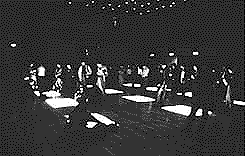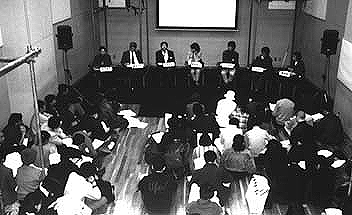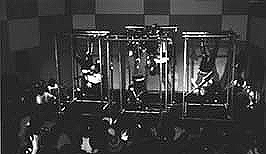
sa Sound Arts vol.5 XEBEC SoundCulture Membership Magazineartist's viewSA on Artists' Viewpoints and Aesthetics |
Caparty Vol. 1 Report
|
| C.A.P. (the Conference on Art and Art Projects), which includes many contemporary artists, has been introduced in SA a number of times and there are probably many of you with an interest in it. At the one-day art party, "Caparty Vol. 1," held at Xebec on October 28, a symposium on the "Former Foreign Settlement Art Center Project" was given. C.A.P. member HARA Hisako reports on what happened at the symposium and the party. |
| This one-day art party consisted of three parts. First, proceeding in order, there was a slide installation, "Pachi Pachi 1000," in the hall. One thousand slides collected from 1,000 members of the public were projected onto the floor using 12 projectors mounted on the ceiling. At an unhurried speed, a relaxed space was created as images from a diversity of photographic expressions segued from one into another against a subdued background of sound . With the participation of the artists who organized Acte Kobe 1 and 2 in Marseilles and Bern, there were the more than 1,000 slides, we received for the installation making it impossible to show them all in a hall. From 2 to 8pm, some walked around the hall, and some squatted down and waiting attentively for their pictures to be shown--there were people enjoying the event in lots of different ways. |  |
 |
In the second part, a symposium entitled, "Talking About the Art Center," was held for two hours beginning at 3pm. As this was the first time C.A.P. had held an event publicly, C.A.P. representative, SUGIYAMA Tomoko began by introducing the group and gave a presentation to explain the group's proposal for an art center project. This continued with a group of guest panelists involved with the project speaking on other aspects of the plan. The "Former Foreign Settlement Art Center Project" calls not for the construction of an art museum in the area, but for changing the area itself into an art museum. |
| During the symposium, there was a driving performance by the art group, RG, that was being given outside, which only those people lucky enough to get a numbered ticket were able to enjoy. As the party began, there was "anti-gravity" music played by the band, Johnny, followed by a kotsuzumi (Noh percussion) performance by HISADA Shunichiro. In this relaxed atmosphere, people continued conversing throughout. From as far as Saitama, Nagoya, and Shikoku, more than 360 people took part, and as our first attempt, I'm proud to say that it was quite a success. |  |
The contents of this issue: |
Akio SUZUKI part 2 | FUJISHIMA interviews VOLANS |
SAMAKH Interview |
TOOP Ocean of Sound |
| To SoundArts Back Issues | Back to Carl Stone Home Page | |||